
Anna Pavlovna Pavlova was a Russian prima ballerina. She was a principal artist of the Imperial Russian Ballet and the Ballets Russes of Sergei Diaghilev, but is most recognized for creating the role of The Dying Swan and, with her own company, being the first ballerina to tour the world, including South America, India, Mexico and Australia.
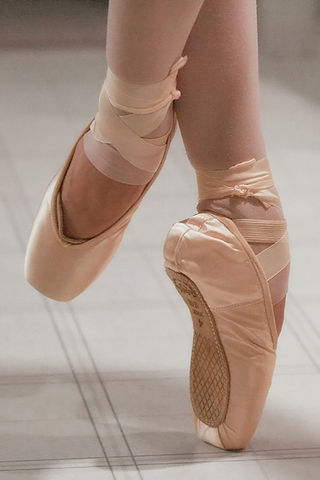
A pointe shoe, also referred to as a ballet shoe, is a type of shoe worn by ballet dancers when performing pointe work. Pointe shoes were conceived in response to the desire for dancers to appear weightless and sylph-like and have evolved to enable dancers to dance en pointe for extended periods of time. They are manufactured in a variety of colors, most commonly in shades of light pink.
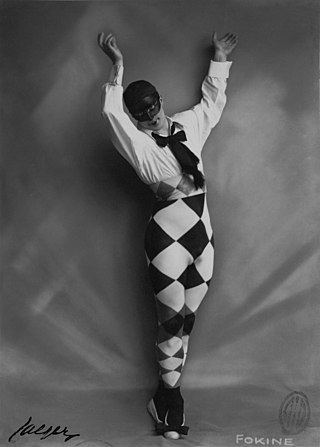
Michael Fokine was a Russian choreographer and dancer.
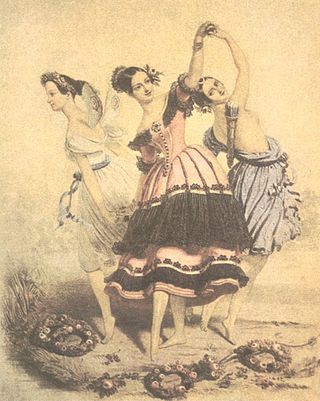
The Romantic ballet is defined primarily by an era in ballet in which the ideas of Romanticism in art and literature influenced the creation of ballets. The era occurred during the early to mid 19th century primarily at the Théâtre de l'Académie Royale de Musique of the Paris Opera Ballet and Her Majesty's Theatre in London. It is typically considered to have begun with the 1827 début in Paris of the ballerina Marie Taglioni in the ballet La Sylphide, and to have reached its zenith with the premiere of the divertissement Pas de Quatre staged by the Ballet Master Jules Perrot in London in 1845. The Romantic ballet had no immediate end, but rather a slow decline. Arthur Saint-Léon's 1870 ballet Coppélia is considered to be the last work of the Romantic Ballet. Romantic ballet is believed to have been experienced in three main phases: The zenith phase from 1830-1840, the decline phase from 1850-1880, and the revival phase in the 1890s prior to Diaghilev. Each phase is synonymous with the production of a few specifically stylized ballets.
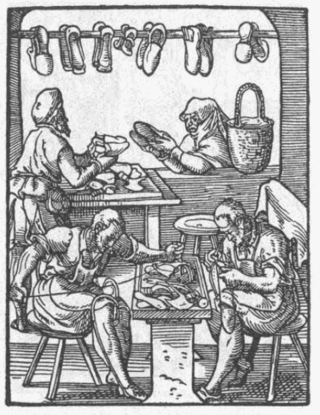
Shoemaking is the process of making footwear.

A ballerina skirt, also referred to as a Juliet skirt or a romance skirt, is a full skirt that is worn by ballet dancers and is composed of multiple layers of fabric. Ballet dancers wear the longer version of the skirt, while for fashion purposes the skirt is worn shorter, like a mini skirt for better dancing, the cocktail version. The standard ballerina attire is composed of fabric with a wire, in order for tulle to be visualized as stiff when it is around their waists. The Juliet styled skirt is free-flowing and covers the majority of their legs to place a high emphasis on the performer's legs.
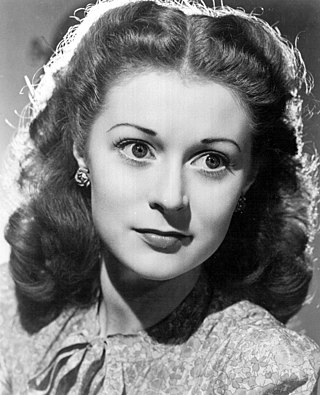
Moira Shearer King, Lady Kennedy was a Scottish ballet dancer and actress. She was famous for her performances in Powell and Pressburger's The Red Shoes (1948) and The Tales of Hoffman (1951) and Michael Powell's Peeping Tom (1960).

La Fille mal gardée is a comic ballet presented in two acts, inspired by Pierre-Antoine Baudouin's 1765 painting, La réprimande/Une jeune fille querellée par sa mère. The ballet was originally choreographed by the Ballet Master Jean Dauberval to a pastiche of music based on fifty-five popular French airs. The ballet was premiered on 1 July 1789 at the Grand Théâtre de Bordeaux in Bordeaux, France under the title Le ballet de la paille, ou Il n'est qu'un pas du mal au bien.
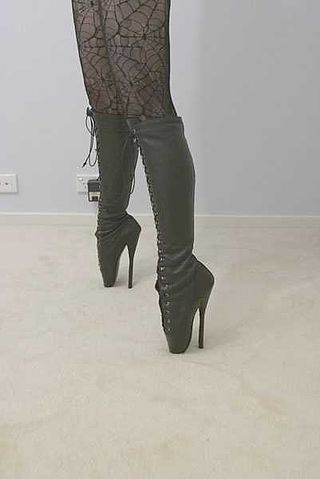
The ballet boot is a contemporary style of fetish footwear that merges the look of the pointe shoe with a high heel. The idea is to restrict the wearer's feet almost en pointe, like those of a ballerina, with the aid of long, slender heels. When upright, the feet are held nearly vertical by the shoe, thus putting nearly all of the body's weight on the tips of the toes. However, a properly tight fit will hold the shoe to the wearer's instep and heel, thereby reducing the weight on the wearer's toes.
Salvatore Capezio (1871–1940) was an Italian-born shoemaker who established Capezio, one of the world's largest manufacturers of dance apparel and specialized dance shoes, including ballet pointe shoes. He was born in Muro Lucano, Italy.

A ballet shoe, or ballet slipper, is a lightweight shoe designed specifically for ballet dancing. It may be made from soft leather, canvas, or satin, and has flexible, thin full or split soles. Traditionally, women wear pink shoes and men wear white or black shoes. Skin-colored slippers—which are unobtrusive and thus give the appearance of dancing barefoot—are worn in modern ballets and sometimes modern dancing by both men and women.
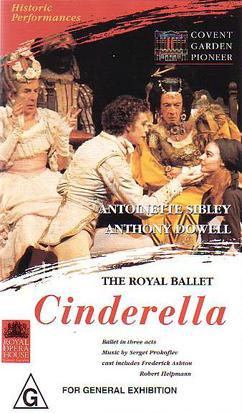
This version of the Cinderella ballet, using Sergei Prokofiev's Cinderella music and re-choreographed by Frederick Ashton, is a comic ballet.

Alessandra Ferri OMRI is an Italian prima ballerina. She danced with the Royal Ballet (1980–1984), American Ballet Theatre (1985–2007) and La Scala Theatre Ballet (1992–2007) and as an international guest artist, before temporally retiring on 10 August 2007, aged 44, then returning in 2013. She was eventually granted the rank of prima ballerina assoluta.
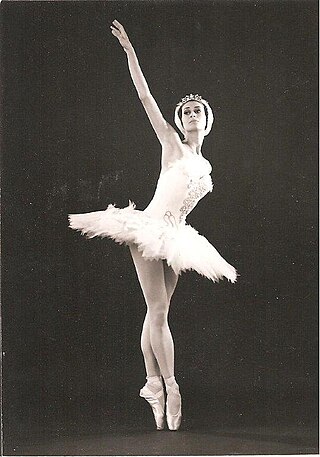
Deanne Bergsma is a South African ballerina, who made her career in the Royal Ballet at Covent Garden. She was born in 1941 and showed early promise as a dancer, She first came to London in 1957 to take up a place in the Royal Ballet School, having been talent-spotted by Claude Newman, former principal dancer and ballet-master of the Vic-Wells Ballet and now a visiting examiner of the Royal Academy of Dance. In two years she had graduated from the school and joined the Royal Ballet company in 1957. She climbed rapidly through the ranks to become a principal ballerina and appeared in a wide array of roles, both classical and contemporary, until her retirement in 1975. This eighteen-year career coincided with an exciting period for the Royal Ballet. Apart from the stream of new works from Ashton and Macmillan the company's resident director-choreographers, it was the heyday of the partnership of Margot Fonteyn and Rudolf Nureyev. The company was touring worldwide and was rarely out of the headlines.

Bloch is an Australian-based manufacturer of pointe shoes and other types of dance shoes, dance costumes, and dance fashion accessories.

Tamara Tchinarova, also known as Tamara Finch, was a Romanian-born émigré Russian and French ballerina who contributed significantly to the development of Australian dance companies and was a Russian/English interpreter for touring ballet companies. She was a dance writer and author, as Tamara Finch, of a number of non-fiction books. She was the first wife of actor Peter Finch.

Grishko Ltd. is a privately held manufacturer of dance shoes, wear and accessories. The company was founded in 1989 by Nikolay Grishko in Moscow, Russia. It is an international company with four factories in Europe and sales in over 70 countries. The company began as a pointe shoe manufacturer and now produces many types of dance shoes and wear.

Mercer Street is a street in the Seven Dials district of Covent Garden, London, England.
Gaynor Minden is the trade name of Gaynor Minden, Inc., an American company that makes shoes, clothing, accessories, and training aids for dancers.
Throughout its history, the costume of ballet has influenced and been influenced by fashion. Ballet-specific clothing used in productions and during practice, such as ballet flats, ballerina skirt, legwarmers, and leotards have been elements of fashion trends. Ballet costume itself has adapted aesthetically over the years, incorporating contemporary fashion trends while also updating fabrics and materials to allow for greater freedom of movement for the dancers. The classic ballerina costume with a tutu and pointe shoes debuted in the 1830s. Ballet costume is marked by the innovation in lightweight materials such as tulle, chiffon, and organza.
















